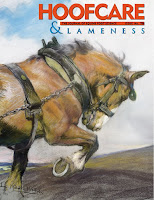This video, produced by Hallmarq Veterinary Imaging, details the procedure involved in preparing for and executing a standing MRI as practiced by Sarah E. Powell, MA, VetMB, MRCVS in the Hallmarq suite at Rossdales Equine Diagnostic Centre in Newmarket, England.
Get ready for some exciting new additions to the Hoof Blog. Over the next few weeks, the H-Blog will present information for and with the assistance of Hallmarq Veterinary Imaging, a company that is recognized as the worldwide leader in standing-MRI imaging of the horse's lower limb.
Now that 14 leading North American university and private equine hospitals are equipped with specialized Hallmarq magnetic resonance imaging (MRI) units for hoof imaging, there is a "need to know" in the horse owner, trainer, technician, therapist and farrier sectors about what this type of veterinary diagnostic imaging involves and what its value to the horse can be. Worldwide, almost 50 Hallmarq lower limb imaging suites are in use; images of almost 20,000 equine lameness cases have been archived in the company's central database. But what does that mean to a horse in my care, or in yours?
That's the process, and while we all are interested in the end results, it's important to know what can be done to best prepare horses for an MRI appointment and to appreciate the valuable information that MRI might provide. Information from leading clinics and lameness specialists will provide insights and perhaps give insight to what the future may hold.
Watch for more in the Hallmarq-sponsored article series this summer, and check their social media system and especially their info-deep web site for lots more information.
To learn more about Hallmarq Veterinary Imaging and standing MRI technology for horses:
• Become a fan of the new Hallmarq Equine MRI Facebook page;
• Follow @HallmarqMRI on Twitter;
• Subscribe to the hallmarqvetimaging channel on YouTube.com;
• Watch for a growing equine distal limb Hallmarq MRI image gallery on Flickr.com;
• Visit the Hallmarq.net web site. (Plan to spend some time there!)
--------
About Hoof Blog sponsored articles: From time to time, the HOOF BLOG publishes articles made possible by the sponsorship of industry partners and advertisers. These articles will always be clearly marked as sponsored content. They are developed and created by Hoofcare Publishing in collaboration with the sponsor. Only articles clearly marked as sponsored content have commercial affiliations. Sponsored content opportunities are available to companies whose programs, events or products are relevant to the educational mission of Hoofcare Publishing and the interests of its subscribers. Please email Hoofcare more information on sponsorship opportunities.









